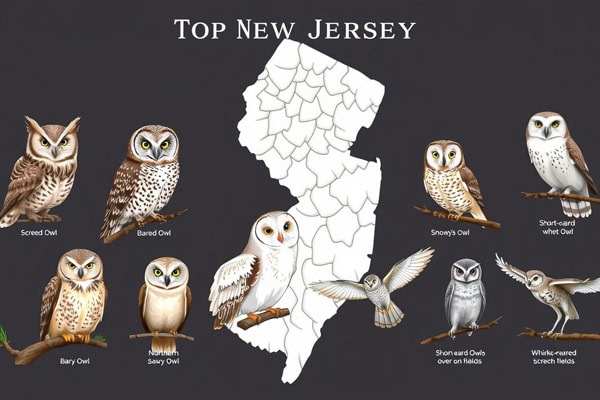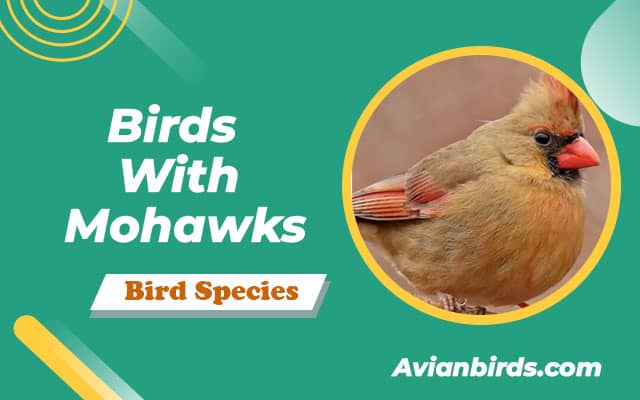9 Types of Owls in New Jersey (ID Guide With Pictures)
Did you know New Jersey has nine types of owls? Each one is unique in its own way. This makes it a great place for birdwatching and nature lovers. In this guide, we’ll look at different owl species, where they live, and interesting facts about them.
If you love birds or just want to learn about local wildlife, you’re in the right place. You’ll find lots of useful information and beautiful pictures of each owl. Let’s explore the skies of New Jersey together and learn about these amazing birds!
Introduction to Owls
Owls are fascinating creatures that capture many hearts. They have unique adaptations and behaviours. Owls are nocturnal raptors with remarkable characteristics, making them great hunters in the dark.
They have extraordinary night vision. This lets them spot prey even in low light. This is a key feature of their own characteristics.
One striking feature of owls is their facial structure. It helps funnel sound to their ears, boosting their ability to hunt silent prey at night.
They also fly silently. This is because of special wing feathers that muffle sound. This lets them sneak up on their prey unnoticed.
Owls live in many places around the world. They can be found in dense forests, open fields, and coastal marshes. For example, in New Jersey, barn owls are common. They like areas with low people and good nesting spots.
Knowing about owls’ adaptations and homes connects us to nature and shows how important owls are for maintaining a balanced environment.
Understanding Owls
Owls are fascinating creatures with unique adaptations and behaviours. Their disk-shaped faces help them locate sounds well, which is key for hunting in the dark.
Another cool thing about owls is that their heads can turn up to 270 degrees. This allows them to see a wide area, helping them find food and stay safe.
Owls have interesting social lives and also like to be alone. Great Horned Owls in northern New Jersey start their mating season in December. They make loud sounds at night.
Barn Owls care for four to eight chicks, showing their nurturing side. Northern Saw-whet Owls, on the other hand, like to stay in open forests near water.
Different owls make different sounds to find mates and mark their territory. Learning about these sounds helps us understand their roles in nature. Owls are amazing to watch, whether they’re flying silently or hunting.
Where to Spot Owls in New Jersey on Map
Here’s a detailed map of New Jersey, showing key locations for spotting owls like the Great Horned Owl, Barred Owl, and more. 🦉🌳 It highlights regions such as the Pine Barrens, Great Swamp National Wildlife Refuge, and coastal areas.
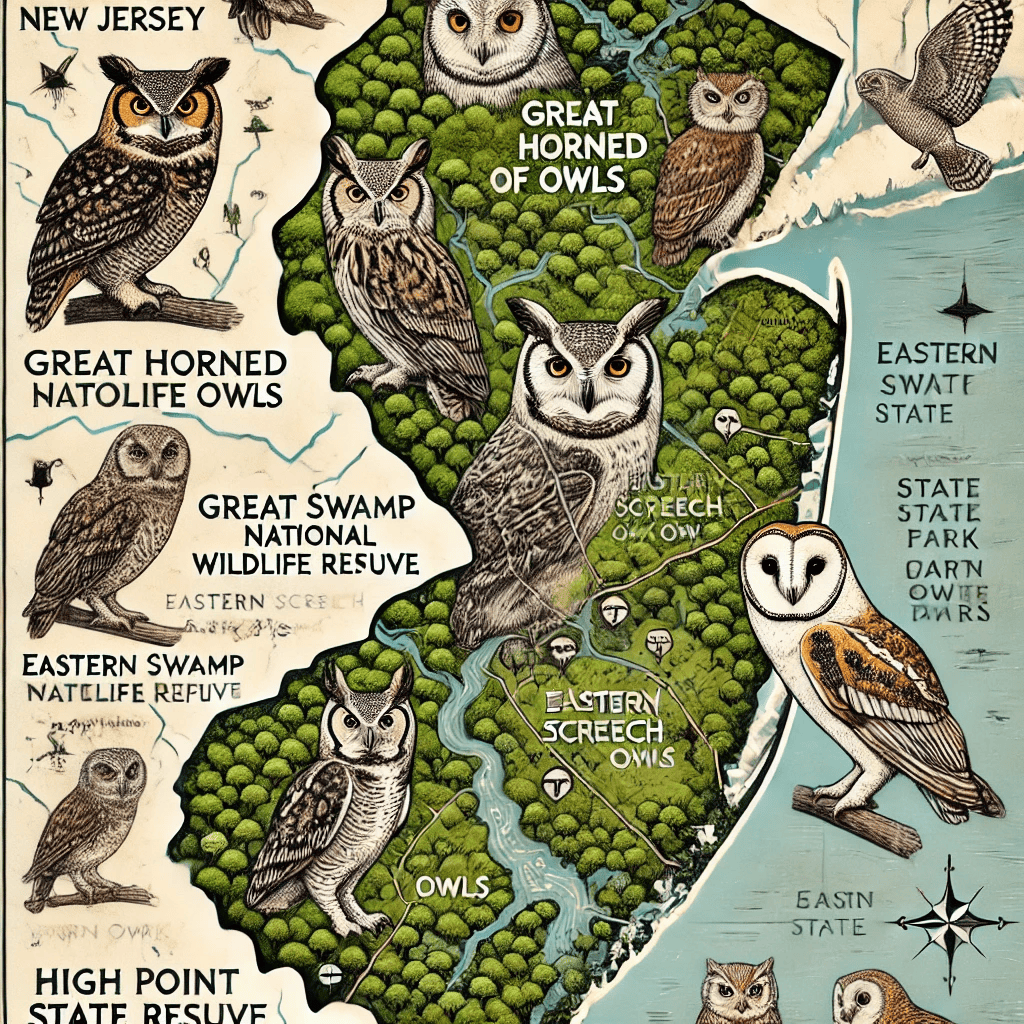
1. Great Horned Owl
- Scientific Name: Bubo virginianus
- Size: 45–63 cm (18–25 in)
- Weight: 1.4–2.6 kg (3–5.8 lb)
- Wingspan: 91–145 cm (36–57 in)
- Lifespan: Up to 28 years in the wild
- Diet: Primarily small mammals, birds, and occasionally reptiles and amphibians.
The Great Horned Owl, known as Bubo virginianus, is a key bird in New Jersey. It has tufted ears and big yellow eyes. It’s the biggest owl in the area, growing up to 25 inches tall and having a 60-inch wingspan.

Description and Identification
Spotting a Great Horned Owl is easy with its brown, grey, and white feathers. Young owls have fluffy white feathers. Their hooting sounds are different for males and females. They fly quietly, thanks to their slow wing beats.
Habitat and Range
Great Horned Owls live in many places, like forests and cities. In New Jersey, they live with other owls and have used old nests for years. New Jersey has eight owl species, with the Great Horned Owl being very common.
| Feature | Information |
|---|---|
| Scientific Name | Bubo virginianus |
| Height | 18 to 25 inches |
| Wingspan | 48 to 60 inches |
| Primary Habitat | Forests, suburbs, rocky cliffs |
| Distinct Features | Tufted ears, yellow eyes, barred plumage |
| Prey | Variety including small mammals, birds |
| Nesting Behavior | Reuse old nests, start breeding in January |
2. Short-eared Owl
- Scientific Name: Asio flammeus
- Size: 33–43 cm (13–17 in)
- Weight: 200–500 g (7–18 oz)
- Wingspan: 86–102 cm (34–40 in)
- Lifespan: Up to 10 years in the wild
- Diet: Primarily small mammals, particularly voles, as well as birds and insects
The Short-eared Owl, known as Asio flammeus, is a special bird. It hunts during the day, unlike most owls. It lives in open fields and grasslands, where voles are common.
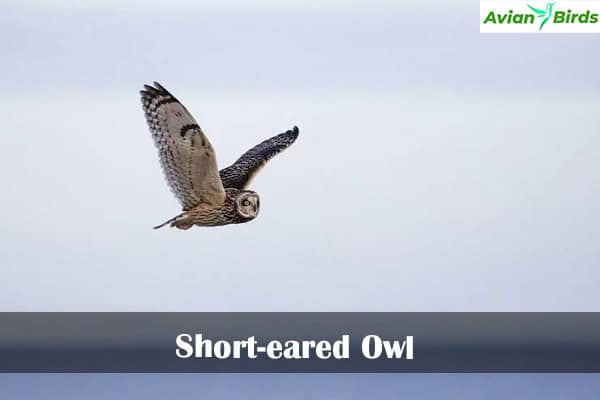
Behaviour and Hunting Practices
The Short-eared Owl hunts in the day, moving gracefully. It flies low, using its sharp eyes to find prey. It’s most active at sunset when it can see well.
This owl nests on the ground, which helps it avoid predators. Its nests blend into the grass, keeping the young safe. Sadly, its numbers have dropped, with no nests in New Jersey since 1979. Efforts to protect its habitat are underway.
| Aspect | Details |
|---|---|
| Common Name | Short-eared Owl |
| Scientific Name | Asio flammeus |
| Hunting Time | Daytime |
| Habitat Preference | Grasslands and Open Fields |
| Breeding Status in NJ | Endangered |
| Last Confirmed Nesting in NJ | 1979 |
| Population Decline Indicator | Breeding Bird Survey (1966-1999) |
| Unique Nesting Behavior | Ground Nesting |
3. American Barn Owl
- Scientific Name: Tyto furcata
- Size: 33–39 cm (13–15 in)
- Weight: 400–700 g (0.88–1.54 lb)
- Wingspan: 80–95 cm (31–37 in)
- Diet: Primarily small mammals (e.g., rodents).
The American Barn Owl, known as Tyto furcata, has a heart-shaped face and a unique sound—a screech. These birds live in old buildings and fields, where they find food and shelter.
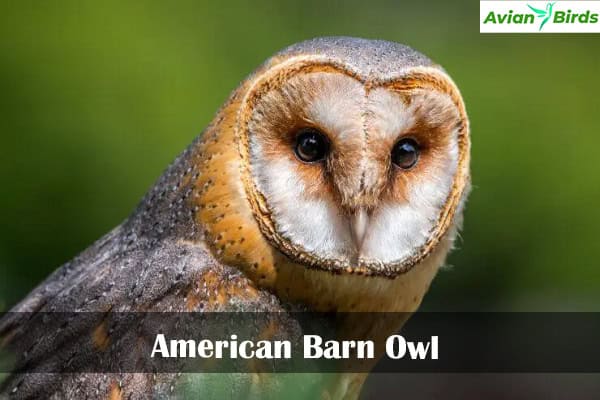
They help control rodent numbers. This makes them important for keeping nature in balance.
Unique Features and Calls
The American Barn Owl can hear very well in the dark. Its loud screeches are heard at night. These birds are mostly alone and have pale feathers and dark eyes.
Their face shape helps them hide while hunting. This makes them good at finding food.
Conservation Status
The American Barn Owl is endangered in many places. In New Jersey, they are working to help them. They use special boxes and fix up old barns for nests.
The Conserve Wildlife Foundation of New Jersey monitors these places and wants to help the owls have more babies. The number of owls in New Jersey has fluctuated.
They had as many as 155 baby owls in one year. Saving these owls is very important.
| Year | Number of Banding | Notes |
|---|---|---|
| 2009 | 155 | Highest recorded number of banded chicks. |
| 2013 | 68 | The lowest recorded number of banded chicks. |
| 2015 | 65 | Successful fledging from 16 of 39 nest boxes. |
4. Northern Saw-whet Owl
- Scientific Name: Aegolius acadicus
- Size: 18–23 cm (7–9 in)
- Weight: 70–150 g (2.5–5.3 oz)
- Wingspan: 50–60 cm (20–24 in)
- Lifespan: Up to 8 years in the wild
- Diet: Primarily small mammals, especially mice, along with birds and insects
The Northern Saw-whet Owl, known as Aegolius acadicus, is a small owl that bird watchers love because of its unique features.
These owls live in dense forests. They build homes in old woodpecker holes and nest boxes, which helps them grow in numbers.
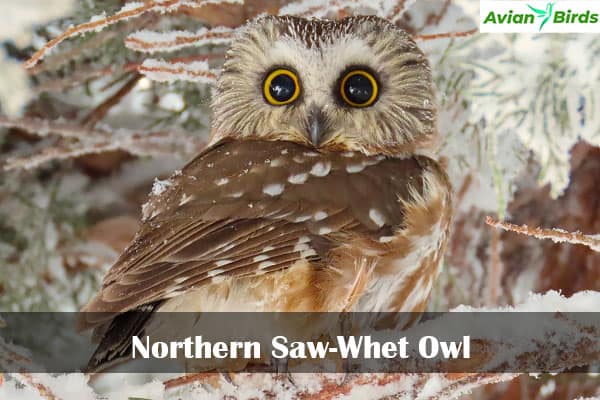
In places like Cape May, they start coming in October. Bird watchers see many of them. Some stay for the winter.
They fly low, which can be dangerous. They might hit cars on busy roads. But, thanks to banding, we know more about them.
Their sounds are special. They make a ‘mewing’ sound and click their bills. This helps them sneak up on prey.
When it’s calm, you can see them migrate. They roost in trees during the day. They hide in dense areas when scared.
| Characteristic | Description |
|---|---|
| Scientific Name | Aegolius acadicus |
| Size | Small owl species |
| Primary Habitat | Dense coniferous forests |
| Migration Timing | Arrives in October; most leave by December |
| Nesting Habits | Uses woodpecker holes and artificial boxes |
| Vocalization | Cat-like ‘mewing’ and bill-clicking |
5. Barred Owl
- Scientific Name: Strix varia
- Size: 40–63 cm (16–25 in)
- Weight: 500–1,400 g (1.1–3.1 lb)
- Wingspan: 100–125 cm (39–49 in)
- Lifespan: Up to 10 years in the wild
- Diet: Primarily small mammals, birds, and amphibians
The Barred Owl, known as Strix varia, is a fascinating bird in New Jersey. It is known for its unique call, ” Who cooks for you?” and its eating habits, which are key to surviving in different places across the state.

Diet and Feeding Habits
Barred Owls eat small mammals like voles, mice, and rabbits, as well as birds, amphibians, and other small animals. This varied diet helps them adjust to changes in their environment.
In New Jersey, where they live, their food choices depend on their habitat. They like mature wet woods with big trees for nesting. These places offer shelter and plenty of food. They avoid cities and human areas, preferring untouched places to live.
The number of Barred Owls in New Jersey is a concern. There are about 37 pairs in South Jersey and 75 pairs in North Jersey. Sadly, there’s been a 30 percent drop in South Jersey due to lost habitats. Saving old-growth forests is key to keeping their food and homes safe.
Learning about Barred Owls’ eating habits shows why we must protect their homes. As their numbers decline, we must keep the environment balanced to help Strix varia in New Jersey.
| Prey Type | Examples | Habitat Preference |
|---|---|---|
| Small Mammals | Voles, Mice, Rabbits | Mature Wet Woods |
| Birds | Songbirds, Amphibians | Undisturbed Forests |
| Other Small Creatures | Insects, Reptiles | Nesting Sites Near Water Sources |
6. Eastern Screech Owl
- Scientific Name: Megascops asio
- Size: 19–25 cm (7.5–10 in)
- Weight: 150–250 g (5.3–8.8 oz)
- Wingspan: 48–61 cm (19–24 in)
- Lifespan: Up to 14 years in the wild
- Diet: Primarily insects, small mammals, and birds.
The Eastern Screech Owl, known as Megascops asio, is fascinating and adaptable. It lives in many places, even cities. It has two colours: grey and rufous. These colours help it hide while hunting and staying safe.
This owl weighs 6 to 8 ounces. It is 7 to 10 inches tall and has a wingspan of 18 to 24 inches. Its unique calls are easy to spot. These calls are important for talking to other owls, especially when they’re looking for a mate.
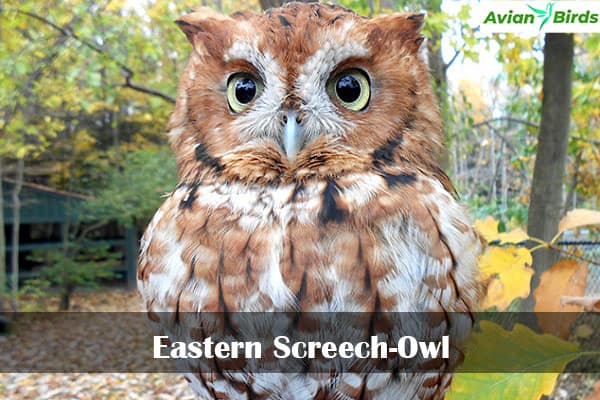
Eastern Screech Owls live in different places. They like dark, moist forests in the south and drier forests in the north. In colder areas, the gray owls do better because they use less energy. It’s also interesting that more females are rufous than males.
These owls are important for controlling rodent numbers. They eat almost 80 percent birds. They are often seen in gardens from August to September. This shows how important it is to take care of their homes and boxes.
To attract these owls, install owl boxes correctly. Place them where they can be seen, like near homes. Keep the boxes clean with pine shavings twice a year. This helps these lovely birds.
| Characteristic | Details |
|---|---|
| Scientific Name | Megascops asio |
| Weight | 6-8 ounces |
| Height | 7-10 inches |
| Wingspan | 18-24 inches |
| Color Forms | Gray and Rufous |
| Diet | Up to 80% birds |
| Common Sightings | August to September |
7. Long-eared Owl
- Scientific Name: Asio otus
- Size: 33–40 cm (13–16 in)
- Weight: 300–600 g (10.6–21.2 oz)
- Wingspan: 86–100 cm (34–39 in)
- Lifespan: Up to 15 years in the wild
- Diet: Primarily small mammals, especially voles
The Long-eared Owl, known as Asio otus, is special. It has big ear tufts and likes to be with others. Unlike many owls, it roosts in small groups. This helps it stay safe and hidden during the day.
This owl is very active at night. It hunts with its great hearing. Its diet includes small rodents and sometimes birds.
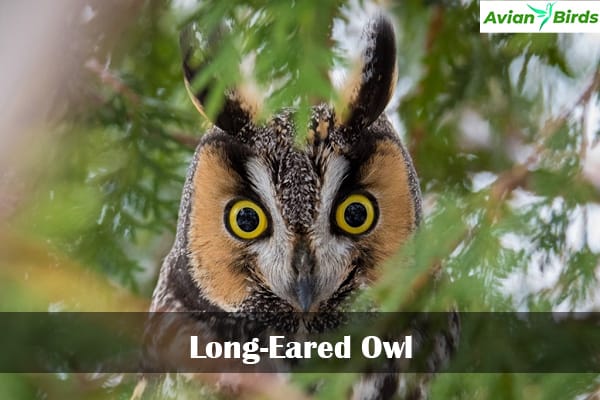
In New Jersey, Long-eared Owls are in trouble. They are now a threatened species. This is because of lost habitats and changes in farming.
Long ago, these owls were found all over New Jersey. But now, they are fewer. They need places with lots of trees and leaves to live.
Learning about Long-eared Owls helps us protect them. We can save their homes and keep them in New Jersey.
8. Snowy Owl
- Scientific Name: Bubo scandiacus
- Size: 51–66 cm (20–26 in)
- Weight: 1.6–2.9 kg (3.5–6.4 lb)
- Wingspan: 125–150 cm (49–59 in)
- Lifespan: Up to 10 years in the wild
- Diet: Primarily small mammals
The Snowy Owl is a beautiful bird that visits New Jersey in winter. It comes from the Arctic and is known for its striking look. It migrates based on food, sometimes visiting the state’s coast.
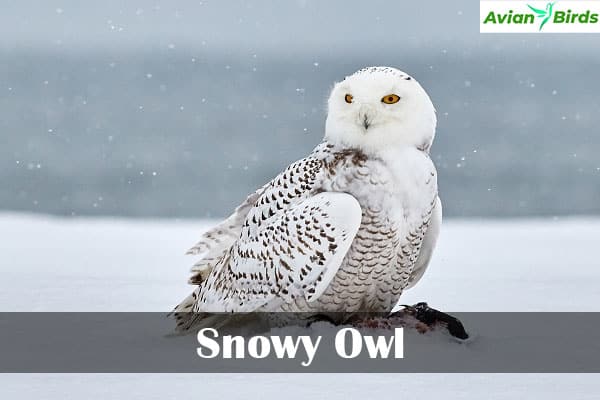
winter migration patterns
Snowy Owls usually live in the north, but sometimes they come to New Jersey. In some years, they come in big numbers, which is rare. In 2013, many Snowy Owls came, which was exciting for birdwatchers.
In 2017, Snowy Owls in New Jersey got electronic trackers. Two young males, “Island Beach” and “Lenape,” were tracked. They showed us where they go during migration. Island Beach was seen in many places, while Lenape went to Ocean City, MD, and Delaware.
Potential places to see Snowy Owls in New Jersey include:
- Island Beach State Park
- Edwin B. Forsythe National Wildlife Refuge
- Cape May Lighthouse Area
- Sandy Hook
- Barnegat Lighthouse
When you go to see them, bring binoculars or a camera. The Raptor Trust in Basking Ridge also has Snowy Owls. But remember to keep a safe distance to not scare them.
As of January 29, 2024, no Snowy Owls have been seen in New Jersey. But they still interest many. Groups like New Jersey Audubon work to protect their Arctic home.
| Year | Tagged Owls | Key Locations | Notable Movements |
|---|---|---|---|
| 2017 | Island Beach, Lenape | Island Beach State Park, Ocean City, MD | Island Beach: North to Sandy Hook; Lenape: Cape May to Delaware Bay |
| 2013 | N/A | N/A | Significant irruption in the state |
Owls in New Jersey: A Local Perspective
New Jersey is great for birdwatching, especially for owl fans. The state is home to eight owl species, like great horned owls and Eastern screech owls. You can see these birds all year, with some migrating in winter.
Best Places for Owl Watching
Looking to see owls in New Jersey? Check out these top spots:
- Island Beach State Park: This place has great habitats for owls, with beautiful coastal views.
- Merrill Creek Reservoir: It’s full of wildlife, perfect for birdwatchers looking for owls.
- Wallkill River National Wildlife Refuge: Famous for short-eared owls, it’s great for winter sightings.
When watching owls, keep a safe distance. Use binoculars or a camera with a zoom. Avoid loud noises to not scare them away. With patience and the right approach, you’ll have amazing birdwatching moments.
| Location | Owl Species | Best Viewing Times |
|---|---|---|
| Island Beach State Park | Great Horned Owl, Eastern Screech Owl | Dusk to Dawn |
| Merrill Creek Reservoir | American Barn Owl, Barred Owl | Early Morning, Evening |
| Wallkill River National Wildlife Refuge | Short-eared Owl | Late Afternoon, Early Evening |
Threats to Owl Populations
Owls face many challenges, with habitat loss being a big one. As cities grow and farming changes, owl homes are lost or broken up, making it hard for owls to find places to nest and hunt.
Habitat Loss and Conservation Efforts
Groups are working hard to save owl numbers. They restore homes and help endangered owls. They build owl boxes and manage land to keep ecosystems healthy.
In places like Illinois and Massachusetts, these efforts are paying off. Nest boxes have helped barn owl numbers go up.
Getting people involved is key to saving owls. When we teach others about owl threats, more can help. Working together, we can keep owls safe for the future.
Read More🐦Related Articles:
| Owls in Minnesota |
| Common Shelduck: Colorful Coastal Duck Species |
| Owls in Africa |
| Owls in Massachusetts |
| Hummingbirds in Texas |
Conclusion
As we finish our look at owls in New Jersey, we must recognize their importance. From the common Barn Owl to the rare Northern Saw-whet Owl, owls show us a complex world. They live in different places and face various challenges.
Conservation is key. Thanks to many efforts, the Barn Owl population is doing well. But we still face big challenges. We must keep working to save these birds from losing their homes and facing other dangers.
Your love for owls can help us all connect more with nature. By supporting local groups and learning about wildlife, you help protect these amazing birds. Together, we can ensure their thrive for years to come.

